Nicole schreibt...
Japan 2018 |
 |
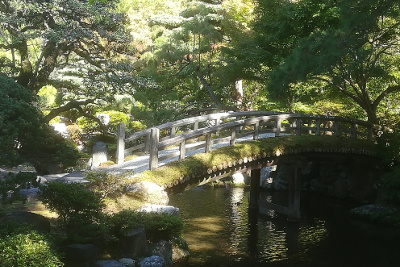 Having ticked China off my long list and seen Korea at least during a brief stop-over in Seoul, I felt that Japan was the last biggie in Asia still missing for me. Now I've never been into Japanese pop culture as much as many others with their love for anime/manga or into Japanese food, but of course it's a fascinating country and Tokyo one of the last great mega-cities I hadn't seen. There are two seasons really in which to visit Nippon: Spring, during the cherry blossom craze, or autumn, when the countless Japanese gardens and parks turn into a riot of autumn colours. So here I was in late October, rather surprisingly with the mother in tow who had invited herself along (having never shown interest in my Asia trips before) and with a direct flight from Frankfurt to Japan's second-largest city Osaka on Honshu island. From there it's just a short(-ish) hop to Japan's old capital city Kyoto, which is not only filled to the brim with great sights but also the best base from which to explore the area. Japan's railways enjoy worldwide fame for their punctuality and reliability and on top of that they also offer "Rail Passes" that are amazing value for money. For something like 222 Euro you get unlimited travel for seven days on nearly all of their trains except the very fastest of the many fast Shinkansen trains and we immediately got ours at the airport to travel onwards to Kyoto.
Having ticked China off my long list and seen Korea at least during a brief stop-over in Seoul, I felt that Japan was the last biggie in Asia still missing for me. Now I've never been into Japanese pop culture as much as many others with their love for anime/manga or into Japanese food, but of course it's a fascinating country and Tokyo one of the last great mega-cities I hadn't seen. There are two seasons really in which to visit Nippon: Spring, during the cherry blossom craze, or autumn, when the countless Japanese gardens and parks turn into a riot of autumn colours. So here I was in late October, rather surprisingly with the mother in tow who had invited herself along (having never shown interest in my Asia trips before) and with a direct flight from Frankfurt to Japan's second-largest city Osaka on Honshu island. From there it's just a short(-ish) hop to Japan's old capital city Kyoto, which is not only filled to the brim with great sights but also the best base from which to explore the area. Japan's railways enjoy worldwide fame for their punctuality and reliability and on top of that they also offer "Rail Passes" that are amazing value for money. For something like 222 Euro you get unlimited travel for seven days on nearly all of their trains except the very fastest of the many fast Shinkansen trains and we immediately got ours at the airport to travel onwards to Kyoto.
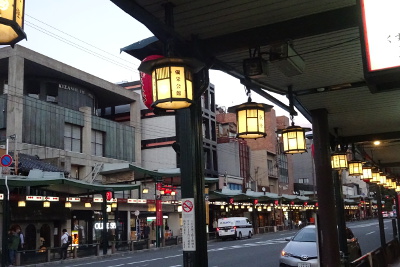 Luckily we were able to check into our hotel early, so we could rest for a while before forcing ourselves out for a first bigger walk to check out the town and combat jetlag. This brought us along the main shopping drag and across the Kamo river to Gion, the 'old town' of Kyoto and famous for being one of the last places where actual geishas and meikos can be found (although most of what you see there are female tourists strolling about in pretty rental kimonos). From here it wasn't all that much further to Kiyomizu-dera, one of Kyoto's many famous temples. This one is a short slog uphill for which you get rewarded by a brilliant view over Kyoto. Sadly it's a city with few outstanding landmarks but at least we got the timing just right and enjoyed the gorgeous sunset on the hill before returning to the hotel for the first night on Japanese soil.
Luckily we were able to check into our hotel early, so we could rest for a while before forcing ourselves out for a first bigger walk to check out the town and combat jetlag. This brought us along the main shopping drag and across the Kamo river to Gion, the 'old town' of Kyoto and famous for being one of the last places where actual geishas and meikos can be found (although most of what you see there are female tourists strolling about in pretty rental kimonos). From here it wasn't all that much further to Kiyomizu-dera, one of Kyoto's many famous temples. This one is a short slog uphill for which you get rewarded by a brilliant view over Kyoto. Sadly it's a city with few outstanding landmarks but at least we got the timing just right and enjoyed the gorgeous sunset on the hill before returning to the hotel for the first night on Japanese soil.
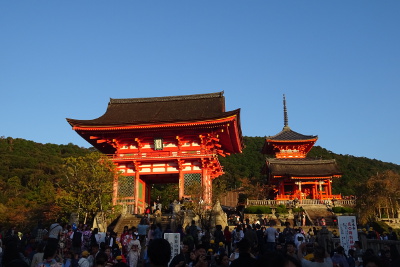
|
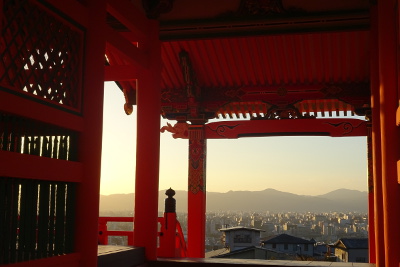 |
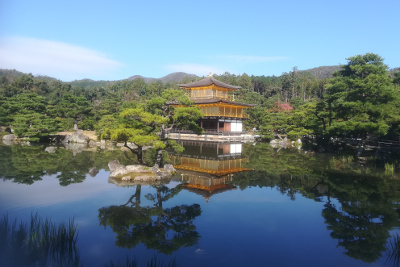 Next morning I had my first encounter with what would prove to be the bane of my trip: Japanese breakfast. While the hotel offered a sumptous buffet it was very much geared towards the Japanese palate with hot noodle soups, fish and the like and very little that appealed to my western taste (cold French fries?!). Thus more or less fortified it was time for sightseeing. Now the sights are strewn all over Kyoto, but the town has little in the way of a functioning public transport system or even the otherwise ubiquitous hop-on-hop-off tourist buses, leaving us no choice but to take a taxi to Kinkaku-ji in the far north-west of the city. The whole temple is actually called Rokuon-ji, but it's mostly famous for its gorgeous Golden Pavilion (Kinkaku), that Shogun Ashikaga Yoshimitsu had built in 1397 (think of the Ashikagas as Japan's version of the Medici, keen supporters of the arts). The golden shrine (actually a reconstruction from 1955 after the real thing had burnt down) forms the centre piece of an incredibly beautiful tranquil garden that was definitely worth the trip out there by taxi and back into the city where our next stop was the Imperial Palace, where the Japanese emperors resided from 794 until 1868 when Meiji took the court to Edo (Tokyo).
Next morning I had my first encounter with what would prove to be the bane of my trip: Japanese breakfast. While the hotel offered a sumptous buffet it was very much geared towards the Japanese palate with hot noodle soups, fish and the like and very little that appealed to my western taste (cold French fries?!). Thus more or less fortified it was time for sightseeing. Now the sights are strewn all over Kyoto, but the town has little in the way of a functioning public transport system or even the otherwise ubiquitous hop-on-hop-off tourist buses, leaving us no choice but to take a taxi to Kinkaku-ji in the far north-west of the city. The whole temple is actually called Rokuon-ji, but it's mostly famous for its gorgeous Golden Pavilion (Kinkaku), that Shogun Ashikaga Yoshimitsu had built in 1397 (think of the Ashikagas as Japan's version of the Medici, keen supporters of the arts). The golden shrine (actually a reconstruction from 1955 after the real thing had burnt down) forms the centre piece of an incredibly beautiful tranquil garden that was definitely worth the trip out there by taxi and back into the city where our next stop was the Imperial Palace, where the Japanese emperors resided from 794 until 1868 when Meiji took the court to Edo (Tokyo).
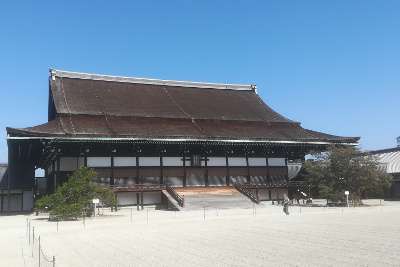 Sadly there wasn't all that much to see with the buildings mostly closed to visitors. Far more fun were the Japanese school kids who ambushed us twice with questionnaires, apparently on a school task to speak English to Gaijin. From the palace it was just a short stroll to Nijo Castle, which Shogun Tokugawa Ieyasu had first built in 1601. It resembled the palace, but at least some rooms could be gawped at here - which turned out to be completely bare, except for a few into which dolls had been placed to recreate the look of meetings between shoguns and visitors. Sadly photos were not allowed inside. The whole complex is embedded in more beautiful gardens that were lovely to stroll in. The tea house I had hoped to visit for lunch was closed, but there were some snack stalls by the exit where we could buy some sushi and I also had my first encounter with Matcha ice cream (which tasted better than I had feared).
Sadly there wasn't all that much to see with the buildings mostly closed to visitors. Far more fun were the Japanese school kids who ambushed us twice with questionnaires, apparently on a school task to speak English to Gaijin. From the palace it was just a short stroll to Nijo Castle, which Shogun Tokugawa Ieyasu had first built in 1601. It resembled the palace, but at least some rooms could be gawped at here - which turned out to be completely bare, except for a few into which dolls had been placed to recreate the look of meetings between shoguns and visitors. Sadly photos were not allowed inside. The whole complex is embedded in more beautiful gardens that were lovely to stroll in. The tea house I had hoped to visit for lunch was closed, but there were some snack stalls by the exit where we could buy some sushi and I also had my first encounter with Matcha ice cream (which tasted better than I had feared).
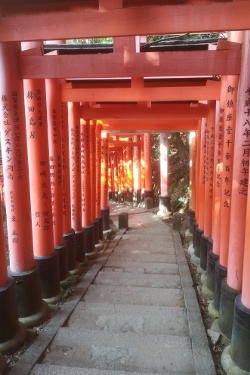
Last destination for the day was the Fushimi Inari-Shrine in the south-east of the city, best known for the thousands of bright-red Torii Gates that line the way up to the top of the hill. Luckily this one was fairly easily to reach by local train for which we could use the Japan Rail Pass for the first time. Each Torii has been donated by a family or company and the further up you go, the emptier it gets, so you actually get a chance for the money shot to be all alone with the torii (see right) while down at the entrance it's mayhem central. Though admittedly we didn't manage to get to the top either, giving up at a nice viewing point half-way up the hill.
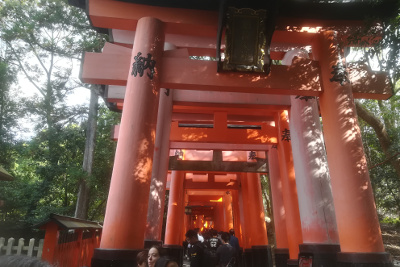
|
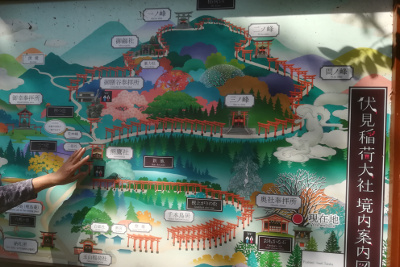 |
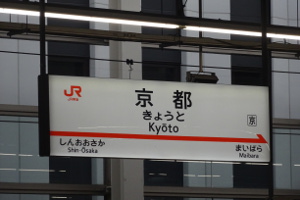
Next morning we threw ourselves at Japan's fabulous railway system properly for the first time to go daytripping. Destination for the day was Itsukushia Shrine on Miyajima island to the south of Hiroshima. Its "floating torii" is one of the most iconic images of Japan and as it turned out we were really lucky that the high tide was in during the morning hours (it's all just a vast expanse of mud at low tide). It's quite a fuss to even get there, changing from the Shinkansen to a local train in Hiroshima and from the local station to the ferry to get to the island. So here's the view from the water to the shrine as well as the far better known view from the shrine to the torii in the water:
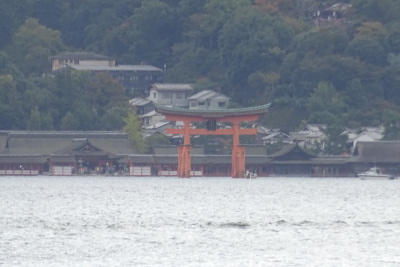
|
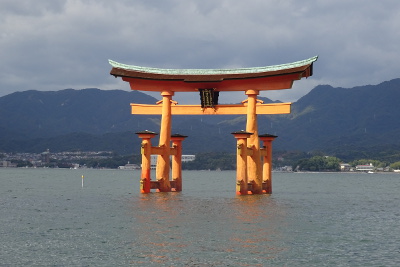 |
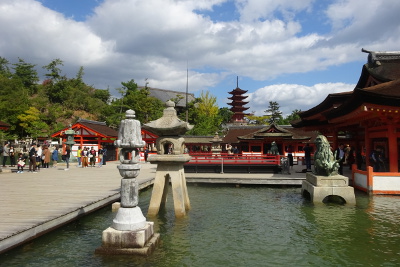
|
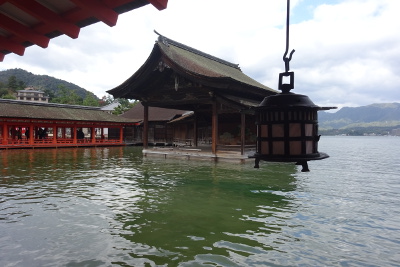 |
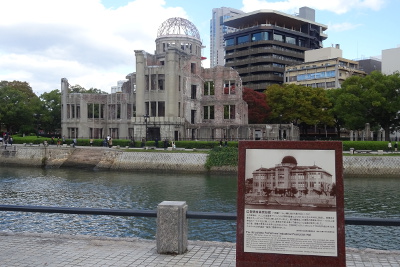 The whole shrine is very pretty, built over water, including a floating stage for No performances that's supposedly the oldest No stage in the world. You could easily spend a whole day on Miyajima island, climbing up the surrounding mountains or doing touristy things, but sadly we didn't have all that much time. Since Hiroshima was the nearest Shinkansen station anyway, we simply couldn't not stop by its Peace Memorial Park in the city centre and luckily there was a direct (pricey) tourist boat between the park and Miyajima.
The name Hiroshima is of course forever tied to 6 August 1945 when the town became the target of the first atomic bomb ever (Nagasaki was hit three days later), killing around 90,000 people immediately, with a further 150,000 victims down the years dying of the after-effects of radiation. The only building left standing was the "Hiroshima Prefectural Industrial Promotion Hall", although everyone inside was killed instantly. After lots of discussions the city decided to keep it as a Memorial called Genbaku Dome (Atomic Bomb Dome) and now a world heritage site. It's directly beside the island of Nakajima, one of the most densely populated parts of Hiroshima that was completely destroyed in the attack and has been rebuilt as the somber Peace Memorial Park.
The whole shrine is very pretty, built over water, including a floating stage for No performances that's supposedly the oldest No stage in the world. You could easily spend a whole day on Miyajima island, climbing up the surrounding mountains or doing touristy things, but sadly we didn't have all that much time. Since Hiroshima was the nearest Shinkansen station anyway, we simply couldn't not stop by its Peace Memorial Park in the city centre and luckily there was a direct (pricey) tourist boat between the park and Miyajima.
The name Hiroshima is of course forever tied to 6 August 1945 when the town became the target of the first atomic bomb ever (Nagasaki was hit three days later), killing around 90,000 people immediately, with a further 150,000 victims down the years dying of the after-effects of radiation. The only building left standing was the "Hiroshima Prefectural Industrial Promotion Hall", although everyone inside was killed instantly. After lots of discussions the city decided to keep it as a Memorial called Genbaku Dome (Atomic Bomb Dome) and now a world heritage site. It's directly beside the island of Nakajima, one of the most densely populated parts of Hiroshima that was completely destroyed in the attack and has been rebuilt as the somber Peace Memorial Park.
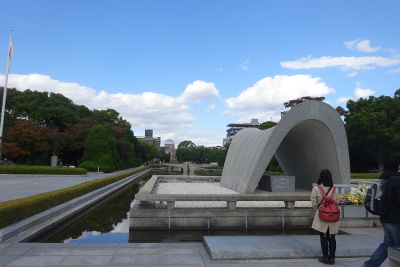
|
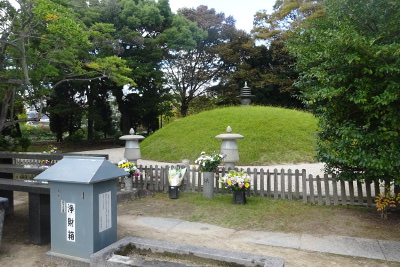 |
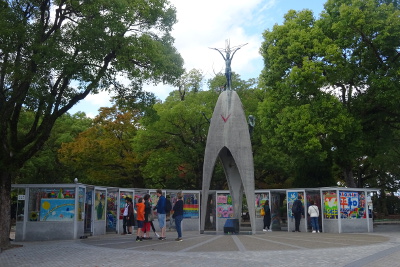 The "flame of peace" in the middle of the central axis in the park is meant to burn until all nuclear weapons have disappeared from the Earth (fat chance), while the large mound is exactly what you think it is - the last resting place for the ashes of countless unidentified victims of the bomb. But perhaps the most moving memorial is the Children's Peace Monument (left) commemorating the many children that died. It was inspired by Sadako Sasaki, a little girl who believed that she would be cured from leukemia (caused by radiation) if only she managed to fold 1,000 paper cranes (the Japanese symbol for longevity). She died before she could achieve her goal, so her class mates finished folding the cranes and to this day school classes from all over Japan and beyond fold cranes and send them to the memorial.
The "flame of peace" in the middle of the central axis in the park is meant to burn until all nuclear weapons have disappeared from the Earth (fat chance), while the large mound is exactly what you think it is - the last resting place for the ashes of countless unidentified victims of the bomb. But perhaps the most moving memorial is the Children's Peace Monument (left) commemorating the many children that died. It was inspired by Sadako Sasaki, a little girl who believed that she would be cured from leukemia (caused by radiation) if only she managed to fold 1,000 paper cranes (the Japanese symbol for longevity). She died before she could achieve her goal, so her class mates finished folding the cranes and to this day school classes from all over Japan and beyond fold cranes and send them to the memorial.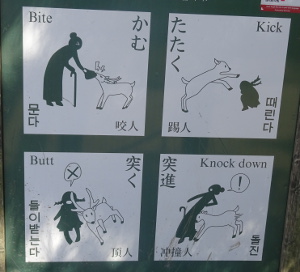 After that rather sober outing, the next outing promised more fun: Nara was the first capital of Japan in 8th century before the emperor moved to Kyoto and among its legacy are the famous "sacred deer" that roam around freely. Legend has it that the god Takemikazuchi arrived in Nara on one such deer to guard the new capital and ever since the Sika deer have been considered heavenly animals. You can buy sika senbei (crackers) to feed them and boy do they get impatient when you don't hand over a cracker swiftly and there are warning signs all over to keep in mind that heavenly or not, they are still wild deer at heart.
After that rather sober outing, the next outing promised more fun: Nara was the first capital of Japan in 8th century before the emperor moved to Kyoto and among its legacy are the famous "sacred deer" that roam around freely. Legend has it that the god Takemikazuchi arrived in Nara on one such deer to guard the new capital and ever since the Sika deer have been considered heavenly animals. You can buy sika senbei (crackers) to feed them and boy do they get impatient when you don't hand over a cracker swiftly and there are warning signs all over to keep in mind that heavenly or not, they are still wild deer at heart.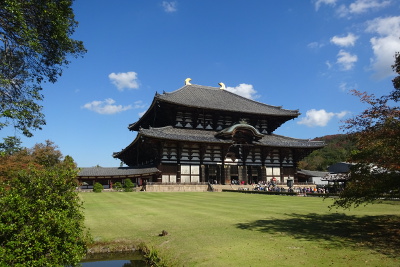 Having escaped the throngs of deer and humans in Nara Park, we made our way to Nara's most famous temple, Todai-ji. Its main hall hosts the largest bronze Buddha (Daibutsu) in the world, which was created during Nara's brief spell as capital. Like most everything in Japan the main hall burnt down a few times and this one dates from 1709. The buddha itself also had to be fixed up several times, with his head being considerably younger than the rest of him. Nonetheless, the statue and its companions flanking him, were really an awe-inspiring sight:
Having escaped the throngs of deer and humans in Nara Park, we made our way to Nara's most famous temple, Todai-ji. Its main hall hosts the largest bronze Buddha (Daibutsu) in the world, which was created during Nara's brief spell as capital. Like most everything in Japan the main hall burnt down a few times and this one dates from 1709. The buddha itself also had to be fixed up several times, with his head being considerably younger than the rest of him. Nonetheless, the statue and its companions flanking him, were really an awe-inspiring sight:
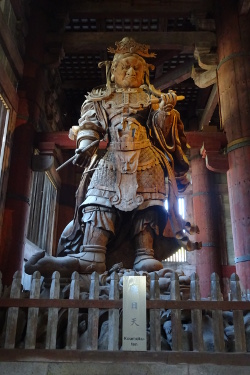 |
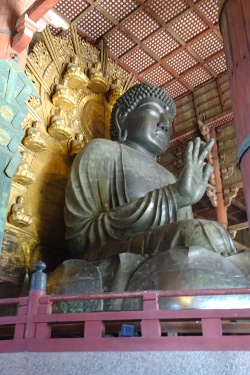 |
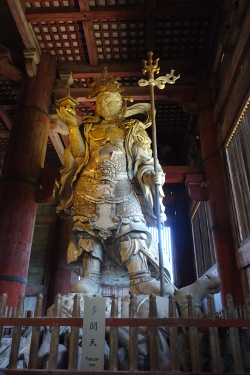 |
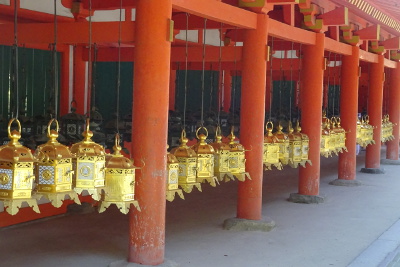
|
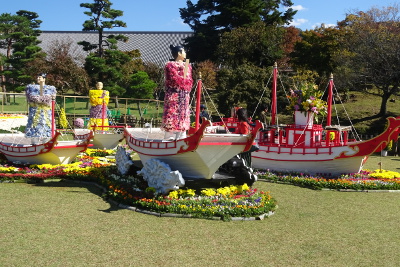 |
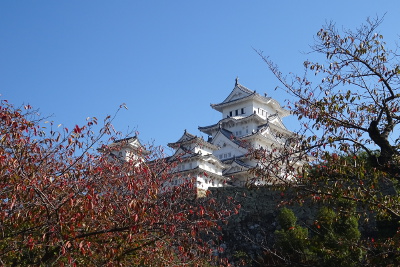
The last day trip from Kyoto took us to Himeji with its impossibly beautiful castle which is also known as "White Heron Castle" for obvious reasons. It first got its present look in 17th century and even survived the bombings of WWII and various earthquakes, although it deteriorated much over the years and was only restored to its incredible snow-white beauty in 2015. It's the largest castle in Japan and a perfect representation of classical feudal Japanese architecture. Sadly, as fabulous as it looks from outside, the main keep is pretty much empty inside, so you can only climb several flights of stairs up to the top floor to enjoy the view, look at empty weapon racks and hidey holes for warriors.
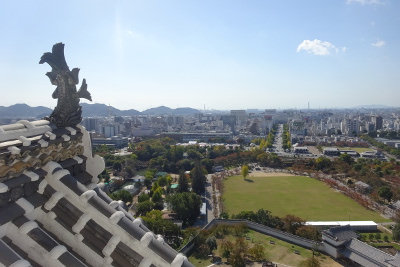
|
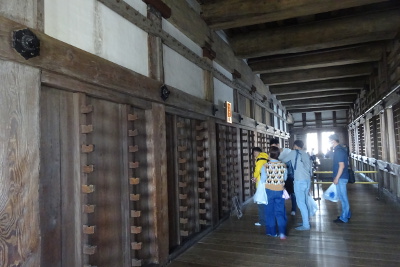 |
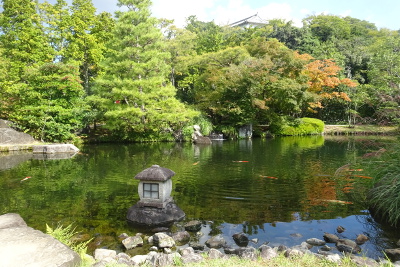
|
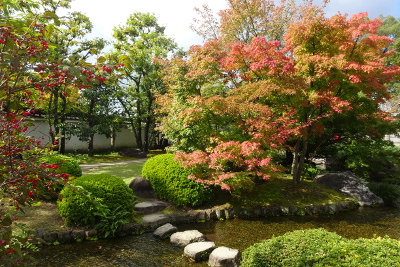 |
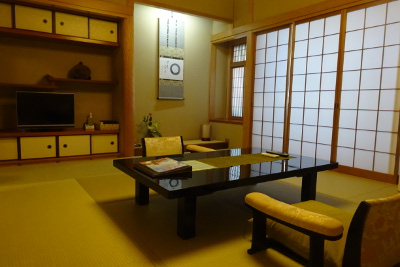 One thing I've also always been fascinated by is the classic Japanese house architecture with its sliding paper doors, tatami mats on the ground and so on. So after returning from Himeji it was time to leave the comfortable modern Hotel Kuu behind to move to a traditional ryokan (Japanese inn) for a final night in Kyoto. It cost an arm and a leg, but came with plenty of personal service, such as being served green tea and a Japanese sweet in our room after arriving and of course the grand kaiseki meal. It's basically traditional haute cuisine with carefully chosen seasonal ingredients that are perfectly balanced in taste, color and texture. Or so it claims. Each of the seven courses was served separately by our "maid" and contained things I'd never thought I'd put into my mouth such as chicken liver in chrysanthemum blossoms, scallops, conger eel and taro. While very little of it admittedly thrilled me, the whole meal itself was just an amazing experience and was filling enough.
One thing I've also always been fascinated by is the classic Japanese house architecture with its sliding paper doors, tatami mats on the ground and so on. So after returning from Himeji it was time to leave the comfortable modern Hotel Kuu behind to move to a traditional ryokan (Japanese inn) for a final night in Kyoto. It cost an arm and a leg, but came with plenty of personal service, such as being served green tea and a Japanese sweet in our room after arriving and of course the grand kaiseki meal. It's basically traditional haute cuisine with carefully chosen seasonal ingredients that are perfectly balanced in taste, color and texture. Or so it claims. Each of the seven courses was served separately by our "maid" and contained things I'd never thought I'd put into my mouth such as chicken liver in chrysanthemum blossoms, scallops, conger eel and taro. While very little of it admittedly thrilled me, the whole meal itself was just an amazing experience and was filling enough.
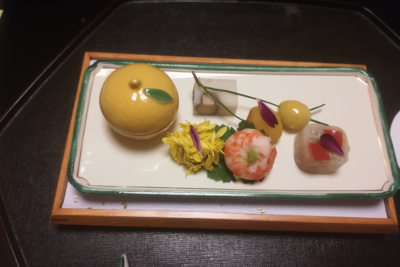
|
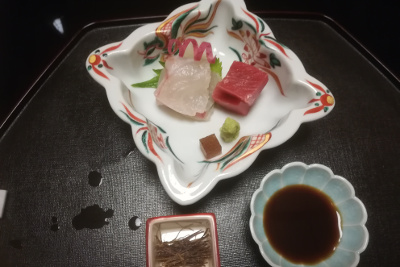 |
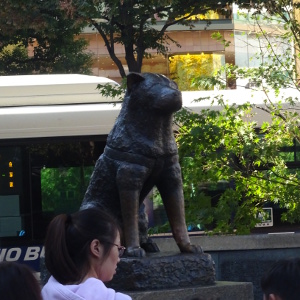 It was time to leave Kyoto behind and head for the great metropolis: Tokyo. We had opted for a hotel near Shibuya Station, famous for the busiest street crossing in the world and also home to Hachiko, the world's most loyal dog: This Akita mutt went to meet his owner daily at the station in 1924-25 when he returned from work. One day his owner did not return, having died suddenly at work, but Hachiko continued to wait for him for nine years, nine months and fifteen days until his own demise. Enough to earn him a statue at Shibuya Station, where people are queuing daily for a photo (and for those who want to know: Yes, Hachiko was buried beside his master). Having said my own hello to Hachiko, we crossed the crossing to head for Starbucks as much for coffee and western sandwiches as for the prime view over the crossing. I mean, it's basically just a street crossing, but it's still an almost entrancing spectacle (and I think it gets so busy simply because the traffic lights are red for a long time in Japan, causing a corresponding built-up of waiting people).
It was time to leave Kyoto behind and head for the great metropolis: Tokyo. We had opted for a hotel near Shibuya Station, famous for the busiest street crossing in the world and also home to Hachiko, the world's most loyal dog: This Akita mutt went to meet his owner daily at the station in 1924-25 when he returned from work. One day his owner did not return, having died suddenly at work, but Hachiko continued to wait for him for nine years, nine months and fifteen days until his own demise. Enough to earn him a statue at Shibuya Station, where people are queuing daily for a photo (and for those who want to know: Yes, Hachiko was buried beside his master). Having said my own hello to Hachiko, we crossed the crossing to head for Starbucks as much for coffee and western sandwiches as for the prime view over the crossing. I mean, it's basically just a street crossing, but it's still an almost entrancing spectacle (and I think it gets so busy simply because the traffic lights are red for a long time in Japan, causing a corresponding built-up of waiting people).
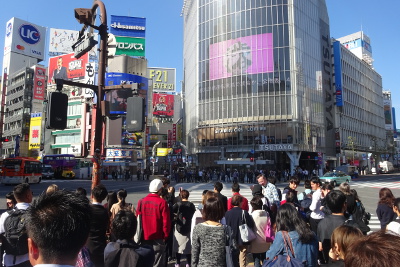
|
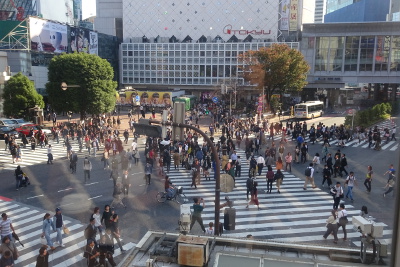 |
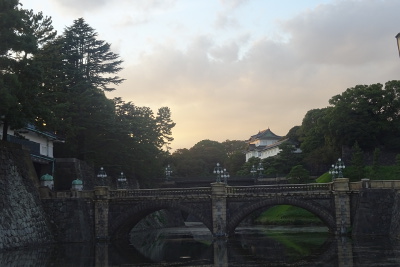 The massive sprawl of Tokyo doesn't feel like one large city spreading outwards from a city centre, but more like an assembly of different towns each with its own centre arranged around the large imperial palace and its parks in the middle. It was this palace Emperor Meiji had built in the restoration that bears his name today and in which he moved the capital from Kyoto to Edo, which was then named Tokyo (Eastern Capital). Luckily Tokyo possesses a great public transport system today including Japan Rail's circular Yamanote Line that connects all the different towns in one large loop (and on which the Rail Pass was valid).
Having checked into the hotel in the early afternoon we took the Yamanote Line to Tokyo Station, a beautiful western-style building from 1914 to walk around the Imperial Palace Gardens. The palace itself is out of bounds as it's still the chief residence of Japan's present Emperor and his family. From there we walked to the posh Ginza shopping area and the Takarazuka Grand Theatre on the vague off-chance that tickets to "Elisabeth" had magically appeared.
The massive sprawl of Tokyo doesn't feel like one large city spreading outwards from a city centre, but more like an assembly of different towns each with its own centre arranged around the large imperial palace and its parks in the middle. It was this palace Emperor Meiji had built in the restoration that bears his name today and in which he moved the capital from Kyoto to Edo, which was then named Tokyo (Eastern Capital). Luckily Tokyo possesses a great public transport system today including Japan Rail's circular Yamanote Line that connects all the different towns in one large loop (and on which the Rail Pass was valid).
Having checked into the hotel in the early afternoon we took the Yamanote Line to Tokyo Station, a beautiful western-style building from 1914 to walk around the Imperial Palace Gardens. The palace itself is out of bounds as it's still the chief residence of Japan's present Emperor and his family. From there we walked to the posh Ginza shopping area and the Takarazuka Grand Theatre on the vague off-chance that tickets to "Elisabeth" had magically appeared.
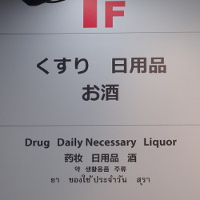 Sadly they hadn't, so we moved on by train to Akihabara, also known as Electric City or these days Geek Central. It's best known for its vast stores selling computer stuff and electronical gadgets, everything to do with Japanese manga and anime culture and nerdy cosplay cafes and the like. Not surprisingly it was full of wide-eyed western tourists gawking (and stocking up on their manga collections), although my childish mind was mostly amused by this sign in one of the department stores. Clearly the Japanese know what really counts as daily necessities! I did avail myself of a very cheap power bank (we'll see how long it lasts) before we returned to Shibuya to find a delicious dinner of katsu (fried pork) in one of the malls by the station to finish our day.
Sadly they hadn't, so we moved on by train to Akihabara, also known as Electric City or these days Geek Central. It's best known for its vast stores selling computer stuff and electronical gadgets, everything to do with Japanese manga and anime culture and nerdy cosplay cafes and the like. Not surprisingly it was full of wide-eyed western tourists gawking (and stocking up on their manga collections), although my childish mind was mostly amused by this sign in one of the department stores. Clearly the Japanese know what really counts as daily necessities! I did avail myself of a very cheap power bank (we'll see how long it lasts) before we returned to Shibuya to find a delicious dinner of katsu (fried pork) in one of the malls by the station to finish our day.
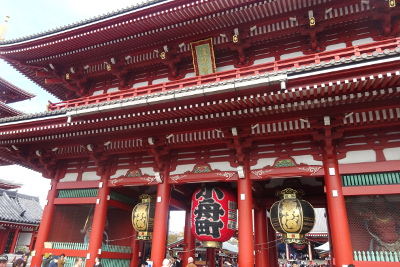 Tokyo isn't really all that big on amazing sights, especially after the onslaught of incredible stuff in the Kyoto area, so next morning we went to Asakusa, which counts as the old city of Tokyo and is host to its most important shrine Senso-ji. The first temple on this site was built in 7th century although the present version was rebuilt after its destruction during the bombing raids on Tokyo in 1945. For 100 Yen you can get your own prophecy in the temple. A lovely alley that once sold religious bits and pieces to pilgrims is now selling snacks and souvenir tat to the tourists and connects the temple with the main street, where the viewing deck on the new tourist information allows a good view on the Sumida River and the massive Skytree, at 634 metres the second-tallest building in the world after the Burj Khalifa.
Tokyo isn't really all that big on amazing sights, especially after the onslaught of incredible stuff in the Kyoto area, so next morning we went to Asakusa, which counts as the old city of Tokyo and is host to its most important shrine Senso-ji. The first temple on this site was built in 7th century although the present version was rebuilt after its destruction during the bombing raids on Tokyo in 1945. For 100 Yen you can get your own prophecy in the temple. A lovely alley that once sold religious bits and pieces to pilgrims is now selling snacks and souvenir tat to the tourists and connects the temple with the main street, where the viewing deck on the new tourist information allows a good view on the Sumida River and the massive Skytree, at 634 metres the second-tallest building in the world after the Burj Khalifa.
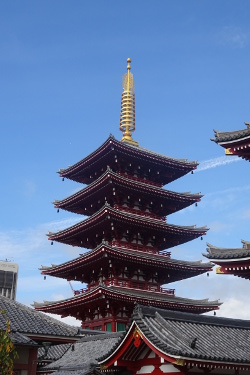 |
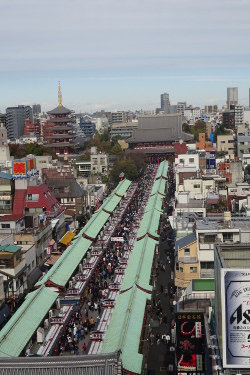 |
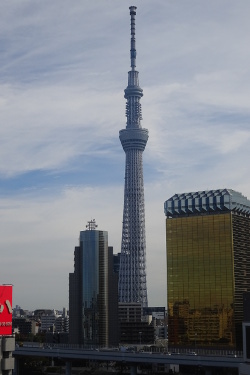 |
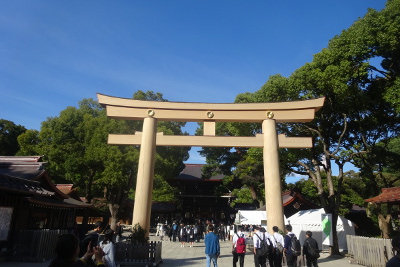
|
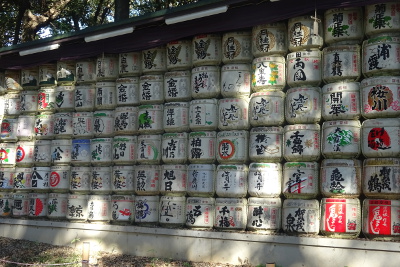 |
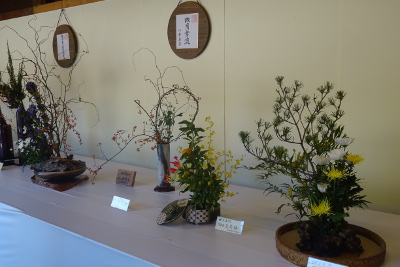
|
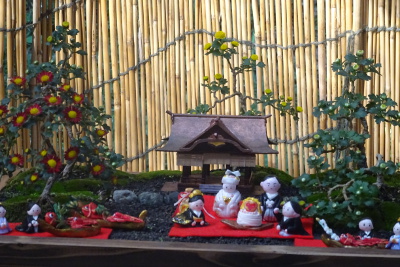 |
 While I had been aware of it being Halloween and seen decorations everywhere, I had no idea that Shibuya would descend into utter insanity in the evening. We had returned to the hotel for a longer break with some delicious Halloween-themed cake and when we went out again for dinner later, found the area around the station completely crammed with people - many dressed up in quite insane outfits somewhere between carnival and cosplay. Somehow it was a fitting end to the craziness that is Japan itself and we did somehow manage to find a lovely restaurant serving okonomiyake and then made it back to the hotel through the crush. And so the time in Japan ended with another morning stroll around Shibuya after breakfast, before taking the Yamanote Line/Monorail to Haneda Airport.
While I had been aware of it being Halloween and seen decorations everywhere, I had no idea that Shibuya would descend into utter insanity in the evening. We had returned to the hotel for a longer break with some delicious Halloween-themed cake and when we went out again for dinner later, found the area around the station completely crammed with people - many dressed up in quite insane outfits somewhere between carnival and cosplay. Somehow it was a fitting end to the craziness that is Japan itself and we did somehow manage to find a lovely restaurant serving okonomiyake and then made it back to the hotel through the crush. And so the time in Japan ended with another morning stroll around Shibuya after breakfast, before taking the Yamanote Line/Monorail to Haneda Airport.
There is certainly a lot to like about Japan, such as the amazingly reliable railway network, the fact that there are clean, free public bogs everywhere and the amazing friendliness of the people. Lack of language never once stopped them from trying to help with the most mundane things from trying to find the right platform in the station to getting coffee out of a stroppy machine at a 7-11. But the food really doesn't do it for me overall. Am I glad I was able to tick Japan off my list? Most definitely! Will I be back? I doubt it. While I love South East Asia and its nations to pieces, the North East with Japan and Korea just feels a tad too alien for me, so look for me further south again in future...
Copyright © All Rights Reserved